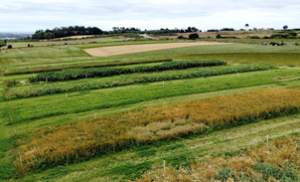Agribusiness News February 2024 – Sector Focus: Soil Management
1 February 2024pHoenix – long-term pH study
The pHoenix long-term experiment is part of the ACE (Aberdeenshire Cropping Experimental) platform. It is based around a pH gradient experiment that evolved from the original Woodlands Field pH plots at SRUC Craibstone’s Aberdeen campus which was established in 1961. This had an 8 course ley-arable rotation superimposed across a pH gradient that ranged from soils adjusted to a target pH of 4.5 through to those with a target pH of 7.5 in 0.5 increments.
In 2021, the field where the experiment was located was destined to be developed for housing, so a decision to move the experiment, all 450 tonnes of it, was made as there is still much to learn about the impact of soil pH on crop productivity and nutrient use efficiency, especially in relation to nutrient recycling and the soil and root microbiomes. All of these aspects are increasingly relevant as policy shifts towards environmentally sensitive approaches to food production and carbon audits.
The move also allowed us to redesign the experiment to enable the soils with a 60-year history of pH adjustment across to be compared with soils that were being adjusted more rapidly from around pH 6.0 to the same target soil pH in paired plots. It also allowed us to modify the rotations to compare different cropping systems across the pH gradient: a 7-year ley-arable rotation, a 5-year arable only rotation, as well as permanent ryegrass and permanent mixed herbal ley beds.

Field Beans
The redesign also enabled us to introduce more diverse arable crops such as field beans into the rotation, highlighting a desire by many farms to move away from the fluctuating costs associated with soybean imports and produce their own home-grown protein, along with their nitrogen fixing and soil health attributes.
The mixed-herbal ley, with its inclusion of a range of forage legumes within the sown species, provides similar relevance to the grassland components of the cropping systems. We are still in the early days of the re-invigorated pHoenix experiment, funded through the Scottish Government RESAS programme, but it is clear the pH’s of the relocated soils have been maintained and their paired counterparts are now starting to adapt from pH 6.0 towards their new target pH, along with an associated impact on the microbial communities and the different crops (see trial site photo below).

pH – soil health and resource use efficiency
If you can maintain good soil structure, drainage, and an appropriate soil pH, you are well on the way to having a successful cropping system. Ideally, soil pH would be optimised across the rotation allowing all crops to grow well. Growers may give more attention to soil used to grow crops of higher value, or those that are delivering greater public goods, e.g. legumes with potential to reduce N fertiliser requirements later in the rotation, but this is not always the case.
A FAS report based on the Soil and Nutrient Network Farms 2016-2018 indicated 47% of soil samples were less than pH 5.8, 35% were between pH 5.8 and 6.2 and 18% were above pH 6.2. There will be a cost-benefit threshold at which the cost of liming beyond a certain pH will provide no benefit to yield and can even reduce it, and also yield penalties, if pH is too low. If the soil pH is not optimised, fertiliser and other agrochemicals that are applied during the cropping season are unlikely to be used efficiently, leading to undesirable consequences in terms of cost-benefit and potential environmental degradation. Linking into this, is the Scottish Government’s “Preparing for Sustainable Farming (PSF)”, which focuses on incentives to help farmers and crofters understand their Carbon emissions and sequestration. It also identifies recommendations that can lower these emissions and increase efficiencies. Soil pH testing a key component of the ‘Soil Sampling and Analysis’ grant.
Robin Walker, Robin.Walker@sruc.ac.uk
Sign up to the FAS newsletter
Receive updates on news, events and publications from Scotland’s Farm Advisory Service

